Recent Articles
-
Christmas Sword Buying Guide 2025
Dec 03, 25 10:53 PM
Samurai Sword History - from the mists of legend to the present day...
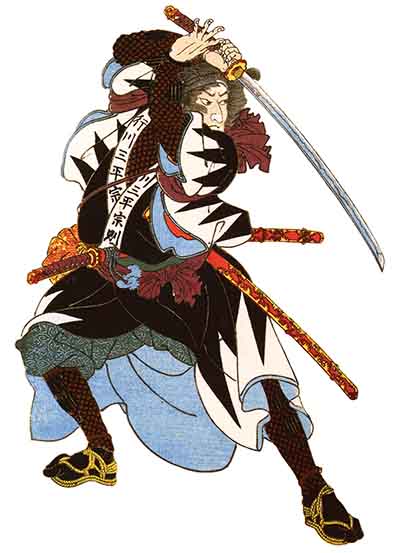
Samurai sword history is roughly divided into four main time periods - Koto (the old sword period, pre 1596), Shinto/Shinshinto (1597 to 1876) Gendai (1877 to the end of world war II) and Shinsaku (modern).
But the earliest origins of this fascinating weapons can be traced back some 1300 years...
The first Japanese swords were basically variations of the Chinese Jian (called Chokuto) - in other words a straight, double edged iron blade, and were virtually indistinguishable from the Chinese swords of the era.
However sometime during the early Heian period, around 700AD, the first uniquely Japanese swords that were the forerunners of the 'modern' Katana began to evolve.
Initially the first curved Japanese swords were curved at the tang only. But by the end of the 10th century fully curved swords were commonplace. It was during this time that Japan began to abandon such close cultural ties with China, it's society stabilized into class divisions, and the military guards of the capital and the gentlemen of the provinces became the first Samurai...
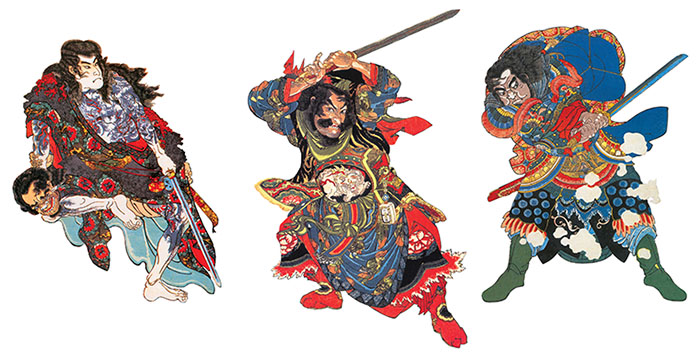 Proto Samurai: The Chinese Influence is clearly visible in their dress and sword style
Proto Samurai: The Chinese Influence is clearly visible in their dress and sword styleWhile no one can pinpoint exactly when the first true Samurai swords came about (after all, written records of Samurai sword history were few and far between during this early period) Japanese myths like to attribute the turning point of Samurai sword history to a smith by the name of Amakuni...
The Legend of Amakuni
- Father of the Samurai Sword
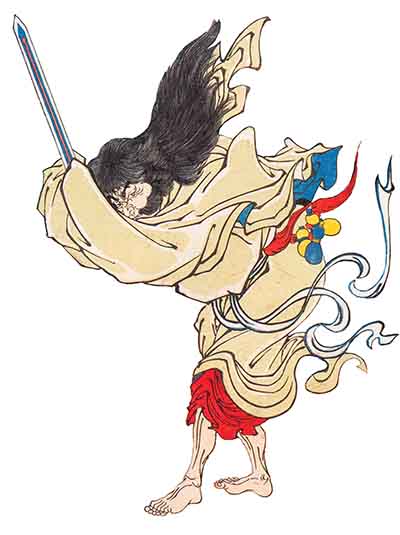
Amakuni Yasutsuna and his son, Amakura, were the head smiths employed by the Emperor to make swords for his armies.
One day, so this legend of Samurai sword history goes, after returning from battle the Emperor and his warriors passed by Amakuni's forge without so much as a word, instead of greeting him warmly as they usually did. With great shame and horror, Amakuni's heart sunk when he noticed that as the warriors came back, most of their swords had been broken or badly damaged in the heat of battle.
Amakuni and his son inspected the damaged and broken blades and realized that their failure was the result of incorrect forging. Vowing then and there to create the perfect sword, and win back the Emperors lost favor, Amakuni and his son locked themselves in the forge and prayed feverishly to the Shinto gods for inspiration.
On the seventh night, the divine came to them both in a dream - a glowing image of a single edged, slightly curved blade...
As soon as the first rays of the sun infiltrated the forge, each knowing without a word exactly what they must do, they set about creating the sword revealed to them by the Kami.
When Amakuni first presented his divinely inspired sword to the emperor, the other sword smiths thought him quite mad. But he persisted, further refining the methods he had developed, until finally, when the warriors returned from battle the following year, not a single sword was broken. The Emperor came up to the smith, and as he passed he said with a smile "You are an expert sword maker. None of the Swords you made failed in battle."
Amakuni had won back the Emperors favor and later died a happy and contended old man...
The Golden Age of Samurai Sword History
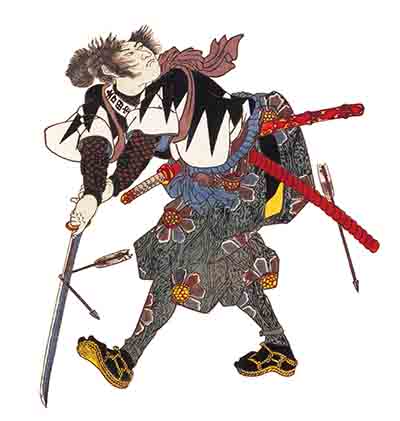
The Kamakura (1192 to 1336) and Muromachi (1337 to 1573) periods were without a doubt the Golden Age of Samurai sword history. After the great Mongol invasion of Japan, which was only narrowly averted by not one but two huge storms that destroyed the Mongol fleets (the Kamikaze/Divine winds) the need for a strong national defense force was apparent and in response new sword smithies appeared all over the countryside.
It was during the last part of the Kamakura that Samurai sword history celebrates one of the most famous and respected smiths came to prominence, the almost legendary Masamune...
The Legendary Masamune
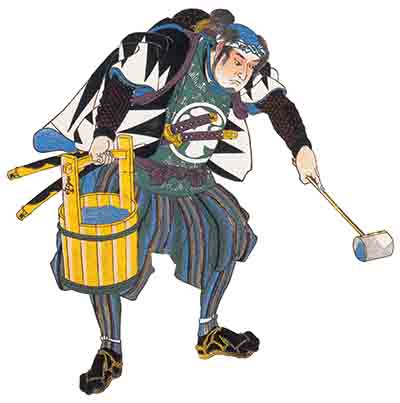
Masamune (also known as Goro Nyudo) was believed to have hailed from Sagami Province and is credited with creating the Soshu tradition of sword making, which involved creating a unique hamon (temper line) of martensitic crystals embedded in pearlite matrix (called Nie), thought to resemble stars in the night sky. Samurai sword history regards Masamune's swords as some of the most beautifully crafted Katana ever made, and his surviving swords are all priceless national treasures.
In Japanese sword folklore, his swords are often contrasted with those of later smith known as Muramasa (approx 1500AD) - with Muramasa's swords being regarded as violent, brutish and evil while the swords of Masamune were considered to be deeply spiritual, pure and benevolent.
One story that best illustrates the differences between these Smiths is a legend that sees Muramasa as Masamune's student (which actually was impossible, as Samurai sword history records these two smiths as being born almost 200 years apart!) challenging his 'master' to see who could make a finer sword.
To test the swords, each sword was held into the current of a stream. Muramasa's sword was said to have cut a leaf in half that simply touched the blade from the current alone. But the master Masamune's sword did not cut a thing, with the leaves miraculously avoiding it at the last second, as if to show it possessed a benevolent power that would not harm anything that was innocent or undeserving - even a simple leaf...
The Sword arts refined
During the 100 year wars of the later Muromachi period, Samurai Sword History records such thirst for weapons to be churned out as quickly as possible that the skills of the sword smiths from the Golden age were lost forever. In 1543 the gun was introduced into Japan, and as many sword smiths now became gunsmiths, the skills of earlier generations deteriorated further still...
Only once these wars were finally over and the great Shogun Hideyoshi unified the country and disarmed the peasantry did Samurai sword history take a turn for the better. Only then, with the Katana being exclusively carried by the privileged Samurai class did the quality of the Japanese sword rise again, though never to the same level as those of the golden age of Samurai sword history.
What followed was 400 years of peace where the gun was rejected and the sword elevated to a fine art. The blades made in this peaceful time of Samurai sword history were known as Shinto (literally "new sword") and were often much more ornate and decorative than practical, though were subject to many rules and restrictions under the stifling power of the Shogun.
It was also during this era that much of the etiquette that surrounds the Japanese sword was refined. For example, at home samurai put their daisho on a double-rack, edge up, katana on top, tsuka to the left (unless they were at war, in which case the tsuka was to the right).
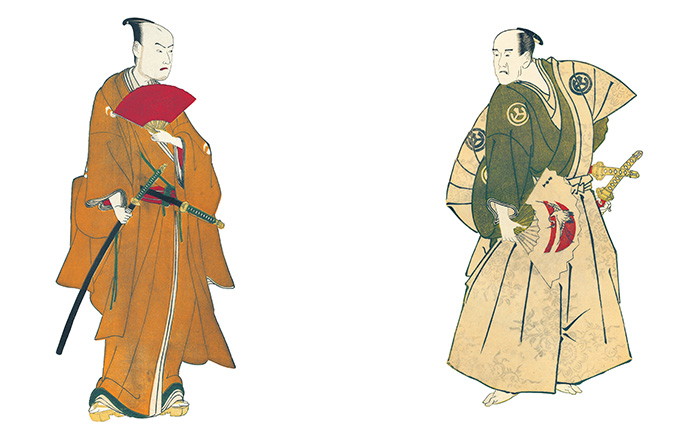 Edo Period Samurai: More gentleman than warrior
Edo Period Samurai: More gentleman than warriorThe appearance of the katana in each era
While the basic forging techniques and construction of the Japanese blade was largely unchanged over 1000 years of Samurai Sword history, the same cannot be said of the fittings - the Koshirae,.
By the Nambokucho period around 700 years ago the Katana had the distinctive tsukamaki wrap and the art of making the fittings, especially the tsuba, were taken over by specialized artisans where previously they had been made by the sword smith himself. Early tsuba were of the Sukashi style, cut out reverse silhouettes, but over time became more ornate with detailed brass and copper embellishments in the Shakudo style - though both styles were in use for the rest of Samurai Sword History.
Around 400 years ago, at the end of the Muromachi period, saw a curious phenomenon, the rise of the 'Samurai punks' the Kabukimono (the crazy ones) . This was a true anomaly of Samurai Sword history and saw the popularity of bright red or other strongly colored saya and flashy, over the top themed fittings, rise as these groups became larger and more prevalent over a 30 year period. Most of the more extreme looking fittings can be attributed to these wild gang members who dressed and acted in a violent and rude manner, terrorized commoners and fought among themselves in the streets at night until they finally faded away after pressure increased on them as the Tokugawa shogunate consolidated its power.
From around 1624 onward, the style, length and color of Katana was heavily regulated by law - red saya and square tsuba favored by the Kabukimono punks were outlawed. And later in the Edo period, all the retainers of the Shogun at the castle in Edo were required to use Banzashi daisho - both Katana and Wakizashi decked out only in the classic black saya and black ito over white rayskin configuration. Even the tsuba of this period were expected to be plain, though subtle dragon, lion dog or floral patterns were tolerated.
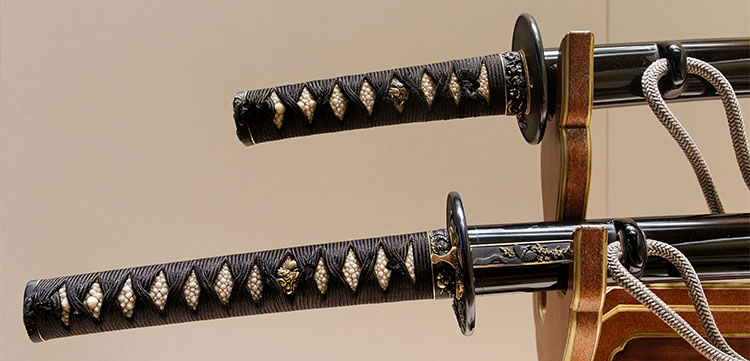 Classic Banzashi daisho, regulation Daisho, with black saya, black ito and white rayskin
Classic Banzashi daisho, regulation Daisho, with black saya, black ito and white rayskinThe Dark Age of Samurai Sword History
In 1876, the Samurai class was officially disbanded and all civilians were ordered to give up carrying swords after encounters with the West made Japan embark on a period of rapid modernization. However, not all the Samurai went quietly, leading to the Satsuma rebellion (of which the movie "The Last Samurai" is loosely inspired by) which was savagely put down.
This was a very dark time in Samurai sword history, as the remaining few
sword smiths were literally put out of business. The wearing of the Samurai sword was banned in 1877, and it was in this period that some Samurai secretly carried a blade concealed in a walking cane - but the writing was on the wall.
The rapidly growing, modernized Japanese army was at first armed with western style cavalry swords, however as their nationalism grew, thousands upon thousands of Gunto were churned out to arm Japanese officers until the end of World War II...
The Katana in the modern era
Actually, the traditional methods of the Japanese sword were nearly lost after Japans defeat in WWII. The allies banned the manufacture of Katana, a ban which is still in effect to the present day, but thankfully exceptions were made for a handful of the remaining master sword smiths.
Since the end of World War II, there have been a handful of smiths both in and outside of Japan attempting to recreate the forging techniques used throughout Samurai sword history.
In recent years there have even been stripped down to the basics, affordable, and very functional replicas created for a hungry Western audience, with the most basic 'entry level' Katana being made and sold for under $300 by modern day sword companies such as Cheness Cutlery, the Hanwei forge, Ronin Katana and Cold Steel to name a few.
However, most interestingly of all, instead of simply going back to the traditions of the past some innovative smiths are taking Samurai sword history forward to the next logical level.
One of the most striking examples of this evolutionary trend is the L6 Bainite Katana made by Howard Clark, a virtually indestructible sword forged using thoroughly modern methods that is in such demand by sword enthusiasts, Howard has not been taking any new orders since 2003...
So while the Samurai are long gone, Samurai sword history continues into a future that seeks to both recover and preserve the old ways, and discover the new.
And with such a resurgence of interest, there is little doubt that a new golden age is dawning...
I hope this information on Samurai sword history has been helpful. To return to A Beginners Guide to Buying Authentic Japanese Swords from A brief overview of Samurai Sword History - from the mists of legend to the present day..., click here.

Buying Swords Online Can Be DANGEROUS!
Find the Best Swords in the:
Popular & Recommended ARTICLES

The ONLY true free online magazine for sword enthusiasts. Delivered once a month on the 1st day of the month, no filler and no BS, just the latest sword news & info delivered straight to your inbox.












